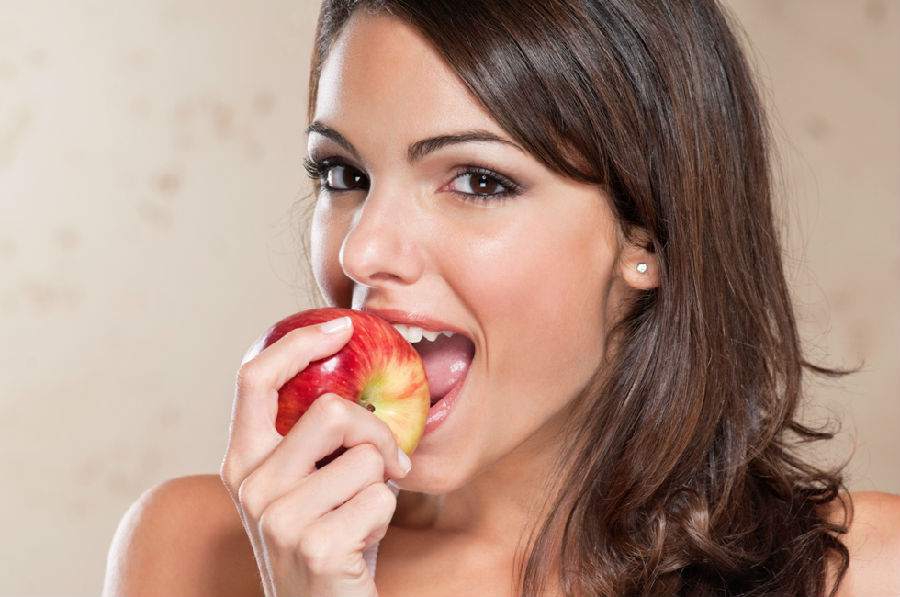(单词翻译:单击)
This ad isn’t what you think.
这则广告并不是你想的那样。
It’s not promoting a sports team or a grill company.
它不是为了推广一支运动队,也不是为了推广烧烤公司。
It’s for an apple.
而是一则苹果广告。
And unlike those that have dominated the produce section when you were a kid,
不同于你小时候见到的那些占了超市农产品区半壁江山的那些品种,
new breeds like this one have catchy names, logos, and slogans.
这些新品种都有朗朗上口的名字、商标和口号,
And are trying to generate buzz before you can buy them.
并且会努力在你下手购买之前先壮大声势。
Historically, our produce has gone unbranded.
曾经,我们的农产品都是没有品牌的。
So how did we end up with all these apples?
那么,我们是怎么有了如今这些分品种的苹果的呢?
For most of the past century, America’s iconic apple was that of Snow White.
在过去的一个世纪的大部分时间里,美国的标志性苹果都是“白雪公主”。
Lipstick red, with shiny skin and a crisp white interior, a.k.a. "the Red Delicious."
像口红一样红,有着光亮的表皮和爽脆的果肉,又名“可口的红苹果”(即蛇果)。
First grown on an orchard in Iowa and originally named after its founder,
这种苹果最早产自于爱荷华州的一个果园,并且最初是以其创始人的名字命名的,
when it came out in the late 1800s, it was dubbed "the best apple of any time.”
当它19世纪后期出现时,它被称为“有史以来最好的苹果”。
Growers and retail stores loved the Red delicious because it looked good.
种植者和零售商都很喜欢蛇果,因为卖相很好。
It was uniform in size and color, turned red before it was ripe, and wouldn’t bruise easily.
大小和颜色均匀,成熟前就红了,而且不会轻易损伤。
And Americans loved the taste.
美国人也喜欢它的口感。
By the 1980s, close to half of all apples grown in the US were Red Delicious.
到了20世纪80年代,美国种植的苹果中有近一半都是这个品种。
The trouble is, when you bite into one now, it often doesn’t taste great.
问题是,现在你要是买一个来吃,通常都不会很好吃。
People complain of mushy flesh and tough skin.
人们会吐槽口感太沙,皮太硬。
Its defining characteristic can sometimes be that it has no flavor at all.
有时,它的标志性特征就是它根本什么味儿都没有。
It takes years and a lot of money to develop a good tasting apple,
培育出一种好吃的苹果往往需要数年的时间,以及大量的资金,
but growers were incentivized to cut costs -at the expense of taste.
但种植者又有充分的动机节约成本——以牺牲口味为代价。
That is, until one apple proved them all wrong. The Honeycrisp.
这种情况一直持续到了一种证明他们都错了的苹果的出现,蜜脆。
The honeycrisp is everything that the Red Delicious was not.
蜜脆和蛇果完全不一样。
When it came out in market in 1991,
1991年上市时,
after 30 years of development, it had a refreshing taste, a delicate skin, and a soft, juicy crunch.
经过30年的培植,蜜脆已经有了清爽的味道,细腻的表皮和柔软多汁脆嫩的口感。
And even though it can cost more than two times the average price of apples,
尽管价格是普通苹果的两倍还多,
consumers then and now are willing to pay a premium price,
以前以及现在的顾客还是愿意高价买这种苹果,
so much so that it’s now the fifth most produced apple in the US.
以至于现在它已经成了美国产量第五的苹果品种了。
So the honeycrisp started a sort of revolution in the apple industry:
总而言之,蜜脆可以说是掀起了苹果行业的一场革命:
Now that people knew expensive, flavor-focused apples would sell,
由于人们已经知道价格昂贵、注重口感的苹果有良好的市场,
breeders experimented to create tastier, more inventive varieties.
种植者们便开始尝试培育更美味,更具创造性的苹果品种。
And they sought to protect their apples’ good names, by patenting their trees and trademarking their brand names.
同时,他们还会通过为果树申请专利,为他们的品种注册商标来设法保护自家苹果的名气。
This process picked up speed after a 1980 federal law allowed universities to own and patent their inventions, including apple trees.
1980年联邦法律允许大学拥有并为其发明,包括苹果树,申请专利之后,这种风气更是愈演愈烈。
And research programs for apple breeding took advantage of the new rules.
苹果育种研究项目也开始将新的规则为他们所用。
In order to plant these new patented varieties, growers had to pay up:
为了种植这些新的专利品种,种植者不得不支付更多的费用:
usually about $1 per patented tree and a portion of sales for use of a trademarked name.
通常每颗专利树要付1美元左右,使用商标名称还要拿营业额出来分红。
Plus, each trademarked apple had to pass muster on firmness, sugar content, blemishes and color.
此外,每个带商标的苹果还必须通过紧实程度,含糖量,瑕疵和颜色等测试。
These quality checks mean that even though the trademarked Pink Lady and the generic Cripps Pink originate from the same type of tree,
这些质检意味着即便带商标的“粉红女士”和不带商标的“粉红佳人”产自同一树种,
they look and taste different — the Pink Lady is held to rigorous trademark standards and that is what, the company says, justifies their higher price.
他们的卖相和口感也会不同——“粉红女士”坚持严格的商标标准,这就是它们卖得更贵的理由,这是他们公司说的。
Now, not all new apples get trademarked.
如今,并非所有新品种的苹果都能拿到商标。
It is only those that experts believe can garner a premium price.
只有专家认为能够卖出高价的新品种才能拿到。
And it can take up to 10 years after securing a patent and trademark to plant and grow enough trees for commercial production.
而且,从获得专利和商标到种植足够的果树用于商业种植,这之间可能需要长达10年的时间。
So while they waited on the fruits of their labor,
所以,在等待他们的辛劳开花结果的同时,
growers worked on marketing their apple in the hopes finding loyal consumers in a competitive market.
种植者还会努力推销他们的苹果,希望在竞争激烈的市场中找到忠诚的消费者。
And they’re not alone.
然而,并非只有他们才这样。
Visit your grocery store and you will see a lot more name brands in the produce section.
去您常去的超市看看,您就会发现农产品区还有很多很多品牌。
Branded fruits and vegetables are a growing trend.
品牌水果和蔬菜越来越成了一种趋势。
While not all branded apples will see success on par with the honeycrisp, there is one that has high hopes.
虽然不是所有的品牌苹果都能像蜜脆那么成功,有一种苹果还是有很大希望能与蜜脆比肩的。
Washington State growers are ramping up production of their Cosmic Crisp,
华盛顿州的果农们正在大力种植他们的“宇宙级脆”,
an apple that’s both sweet and tart, firm and crisp, and much easier to grow than the honeycrisp.
一种又甜又酸,又紧实又脆嫩的苹果,种植起来也比蜜脆更容易。
They’re trying to get people excited about tasting something new and that’s not a bad thing.
他们正努力吸引大家尝尝新品种,这也没什么不好。
While we could see higher prices in the future, the fruits and veggies themselves will be objectively better.
虽然以后蔬菜和水果的价格会越来越高,但它们本身也会更好。
And consumers will have more options, just like we do with our phones, or our computers, or our cereal.
消费者也将有更多选择,就像我们用的手机,电脑,吃的麦片一样。
And now, our apples.
只是,现在轮到苹果了。


